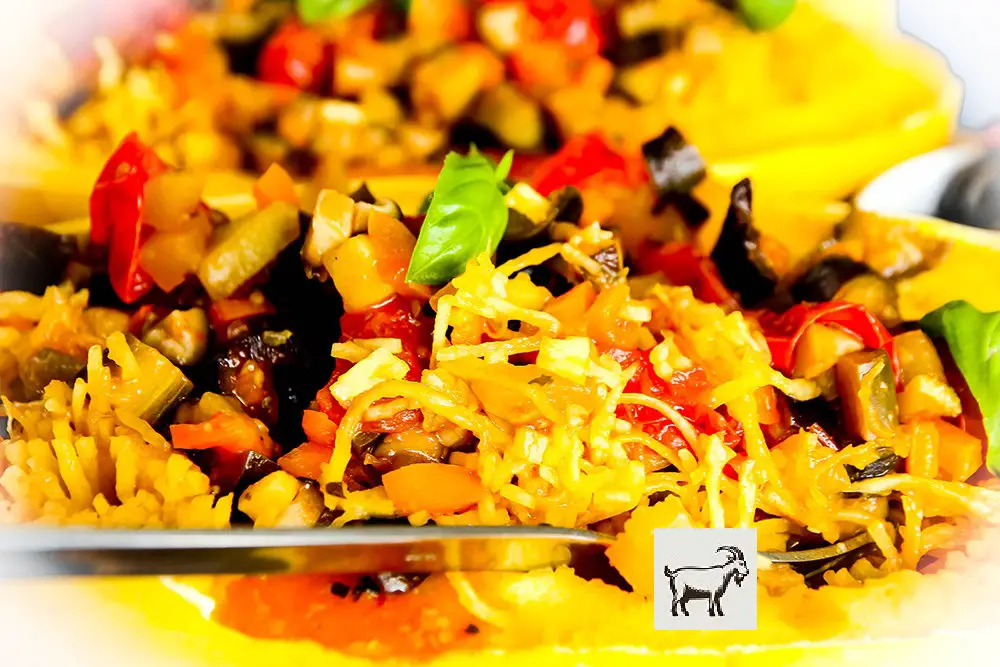🧑🍳 Stuff to Know Before You Start
Spaghetti Squash 101: Look for a ripe, firm squash. A quick pre-roast makes it much easier to cut in half and helps pull out moisture for that perfect spaghetti-like texture.
Tomato Types: Cherry or olive-shaped tomatoes have a more intense flavor and less water content—ideal for a thicker, tastier sauce.
Ratatouille Blend: Traditional ratatouille often includes aubergine, courgette, peppers, and tomatoes. Feel free to add onion or garlic if you like!
Oven Safety: Handle the squash carefully when removing it mid-bake. Using oven mitts and a stable cutting board is essential to avoid slips with the hot squash.
🥄 Ingredients
- 1 spaghetti squash
- 5 shiitake mushrooms, chopped
- 1 aubergine (eggplant), diced
- 500g cherry tomatoes, halved
- 150g courgette, chopped
- 1 long pepper, chopped
- A few basil leaves, torn
- 10 olives, chopped
- Salt (to taste)
- Plant oil (for sautéing)
📝 Step by Step
Soften & Slice
Preheat your oven to about 200°C (400°F). Place the whole spaghetti squash on a baking tray. Bake for 20–25 minutes to soften the rind. Carefully remove from the oven, slice in half lengthwise, and scoop out the seeds. Flip the halves cut-side down on the tray, and bake for an additional 20–25 minutes until the flesh can be easily scraped into spaghetti-like strands.
Prep the Ratatouille Components
While the squash is baking, chop 5 shiitake mushrooms into small pieces. Dice the aubergine, courgette, and long pepper into similar sizes. Halve 500g cherry tomatoes. Chop about 10 olives. Set everything aside.
Start the Ratatouille
In a frying pan, heat plant oil. Add a little salt to prevent splattering. Sauté the shiitake with the aubergine for a few minutes. Stir occasionally so the pieces brown evenly.
Add Remaining Veggies
Toss the cherry tomatoes into the pan, stirring gently. After a few minutes, add the courgette and long pepper. Continue cooking until the vegetables soften and the tomatoes release their juices. Stir in the chopped olives. Finally, tear a few basil leaves over the mixture for a fresh finish.
Squash Meets Ratatouille
Remove the spaghetti squash halves from the oven. Use a fork to scrape out the flesh—it will come apart in strands, just like spaghetti. Plate your squash “noodles,” and top them generously with the ratatouille.
🍽️ How to Serve This Squash & Ratatouille
- Light Lunch: Enjoy the squash and sauce alone, perhaps with a slice of crusty bread.
- Hearty Dinner: Pair with a green salad or steamed beans for extra plant-based protein.
- Leftover Magic: Reheat leftovers in a pan with a little olive oil or tomato sauce for a next-day treat.
🧠 The Science Behind Success
Partial Pre-Bake: Warming the squash first makes cutting it in half safer—no more wrestling with a rock-hard rind.
Avoid Mushy Veg: Aubergine loves to soak up oil. Sauté it first with the shiitake to capture that flavor while keeping some bite.
📖 From Kitchen Curiosity to Culinary Match
Spaghetti squash is a bit of a kitchen enigma—raw, it’s nearly impossible to cut. But once partially baked, slicing it open reveals a hidden secret: pasta-like strands that separate easily from the rind. Combine that with a classic French-inspired ratatouille—full of aubergine, courgette, and tomatoes—and you get an elegant, low-carb meal bursting with summer flavors.
The basil garnish is more than just a finishing touch; it brings a fresh, herbal note that ties all the roasted veggies together. Each forkful becomes a perfect marriage of textures: the firm yet stringy squash paired with the tender, saucy vegetables.
❓ Reader Questions Answered
No. Shiitakes add a savory depth, but button or cremini mushrooms work too. Adjust cooking time as needed since they have higher water content.
Regular tomatoes can be used—just chop them into pieces and remove extra seeds if they’re overly watery. This keeps the sauce thick.
Yes. Store the strands in an airtight container for up to 2 days. Reheat gently in a sauté pan or microwave. Keep the sauce separate for best texture.
This recipe is inherently gluten-free. Just ensure the salt and plant oil you use have no additives. Spaghetti squash naturally replaces traditional pasta.


